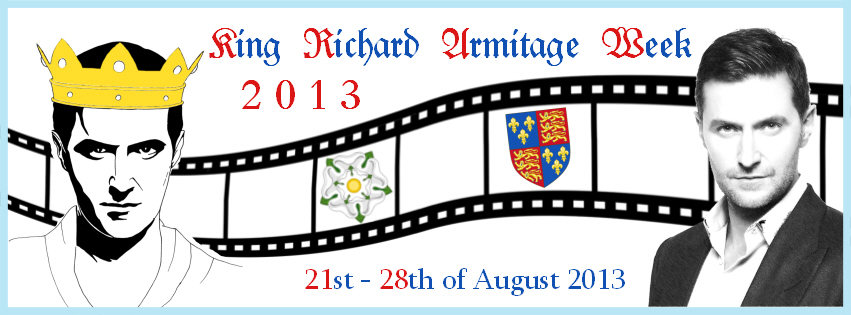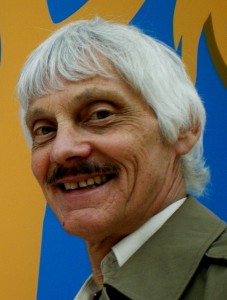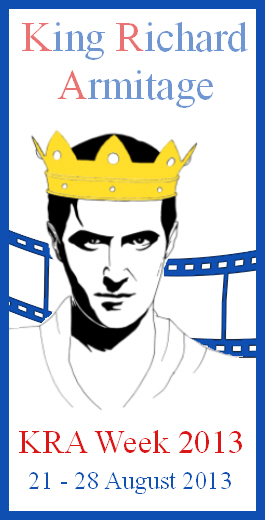Congratulations & Commemoration – KRA-Quiz 2015 Opened !
♛ Happy Birthday Richard Armitage ♛
Happy Birthday, Mr. Armitage !!!
Success, fulfillment and happiness and the most essential, health, on your life’s journey.
And always enough chocolate to make your day!
♛ KRA-Quiz 2015 ♛
With a rush and a hectic a new year went away like a slight brush of wind and once again it is time to find our champions.
Though I was a bit disappointed by the rather localised event for King Richard III in Leicester, which in my opinion could have been a country wide, if not even a world-wide event,
the KRA-website does not discriminate or exclude from our quiz!
Wherever you are, from wherever you join us, take part and try your knowledge
- about King Richard III
- and Richard Armitage.
KRA once again searches for the King Richard III-Champions.
This year, we search two champions.
In the previous quizzes it became apparent that some have strengthes on one or the other side, meaning Richard III or Richard Armitage.
So this year, we search for two separate champions:
- The King Richard III – Champion 2015 and
- the Richard Armitage – Champion 2015.
Winning prices are:
- For the winner in the RIII-part (Page 1 of the quiz):
- For the winner in the RA-part (Page 2 of the quiz):


All participants till 30 September 2015 (in all time zones around the world) will take part in the drawing.
All questiones need to be answered, even if you know your strength is only on one page of the quiz. So two chances to win in one quiz!
The winners will be announced here on King Richard III’s birthday, the 2 October 2015.
I wish you all a successful and enjoyable quiz and a good time!

Go to KRA-Quiz 2015
Happy Birthday & Quiz Winners Revealed !
Happy Birthday, King Richard III !
To be exact, happy 562. birthday !
KRA has no real birthday present for King Richard III, but we have three wonderful presents for our three
KRA-Champions 2014,
who won the KRA Quiz 2014:

The prices for our winners are:
- “Finding Richard III: The Official Account“, by Annette Carson, Philippa Langley, Dr. Ashdown-Hill (Pb)
- “Richard III: A Small Guide to the Great Debate” by Annette Carson (Pb)
- “The King’s Grave: The Search for Richard III“, by Philippa Langley, Michael Jones (Pb)
Our three winners and this year’s King Richard Armitage – Champions are:
- Iwona
- Janet Slocombe
- Andrea Castano

And they really are champions.
I admit, the quiz was hard this year, really hard.
So again this year, the selection of the winners was a point decision.
Still, I hope you all had fun answering the trick- and not so tricky questions.
The solution-page unfortunately was accumulated in a bit of a rush, as I had an overly hectic month of September, but I will try to extend it with more details and background information.
Happy Birthday RA & Commemorating Richard III – The Quiz is Open !
Many of you know, that on this day, now already two years ago, a for my life important person died. So this day, with its joy about Richard Armitage’s birthday, always holds the vivid image of loss for me as well.
What must it have been for Richard Armitage, growing up and always being reminded on his birthday, that King Richard III lost his life on exactly that day?
We nonetheless hope, Richard Armitage celebrates a wonderful birthday and has an exceptional performance of “The Crucible” at the Old Vic.
Happy Birthday, Mr. Armitage!
To celebrate both, the joy and the commemoration, KingRichardArmitage is doing a new Quiz.

All participants till 30 September 2014 (in all time zones around the world) will take part in the drawing.
The winners will be announced here on King Richard III’s birthday, the 2 October 2014.
As last year, the KingRichardArmitage-Champions will be drawn by chance among the most complete and correct Quiz entries.
Prices for the winners are three recently published books about King Richard III and the search in Leicester published by the restlessly and confidently pursuing team of the ‘Looking for King Richard Team’:
- “Finding Richard III: The Official Account“, by Annette Carson, Philippa Langley, Dr. Ashdown-Hill (Pb)
- “Richard III: A Small Guide to the Great Debate” by Annette Carson (Pb)
- “The King’s Grave: The Search for Richard III“, by Philippa Langley, Michael Jones (Pb)
So it is worth to win and try your luck. Take your time, browse around and have a look around the KingRichardArmitage website, as for most of the questions the answers can directly be found on the KRA website.
The Quiz is Opened ! – Good Luck !
KRA-Week 2013: Thank You
! Congratulations !
to our KingRichardArmitage Champions
We have the winners of this year’s quiz!
The quiz remains open so that you can further try your knowledge,
but the book prizes will go to:
Fabi & Kathryn Barnes
To my great surprise, it was a point decision and not by random number selected from all the correct answers.
And I had thought, I had made the quiz much too easy.
Sorry! Solutions are available here now.
Quiz prizes are: Two books by
Isolde Martyn “The Devil in Ermine”
♛
Thank You !!!
to all interview partners
- Authors Isolde Martyn & Matthew Lewis – for their wonderful novels about King Richard III,
- Peter Warzynski – for his insights into archaeology and sharing first-hand Leicester experience with us,
- Fitzg – for her insights into King Richard III’s clothes,
- Jim Cowan – for exploring King Richard’s Wales,
- Dr. Ashdown-Hill – for enabling the find of King Richard III, and
- MaryAnn & Michael Tedstone – for bringing King Richard III back to life in music,
and all our helpers and contributors
of the King Richard Armitage Week 2013.
It was a fantastic experience for me
and I hope you enjoyed the celebrations!
KRA-Week 2013-8: Historical Music – The Orpheus Project
Links: King Richard Week 2013 & Quiz
! Attention !
The winners of the quiz are final and will be announced in a separate post today, where also the link to the quiz solutions will be revealed.
♕ ♛ ♕
King Richard III & Music
An interview with MaryAnn & Michael Tedstone
The Orpheus Project
Peter Warzynski in his interview (25.08.2013) gave us so insightful background information about Leicester and the euphoria about finding King Richard III there.
What better method is there to express happiness and joy than in music?
So I am very happy to present a Leicester based team of composers, MaryAnn & Michael Tedstone, with their group
The Orpheus Project
The two composers, MaryAnn & Michael Tedstone, brother and sister, are famous for their film music and their successful effort to combine old traditions with new musical elements.
They embrace the history and time of King Richard III and present musical elements and lyrics he might have known or heard himself in their new recording:
“The Last Plantagenet”
To tease you a bit with the wonderful music, here is a sample of “The Last Plantagenet”.
And I can assure you, it is worth having a look around the websites of the composer team, as their diverse music really is a joy and has a wide bandwidth of styles. I already spent quite a while on their websites and listened to their wonderful music:
- www.orpheusproject.co.uk
- www.manikemusic.com
- The Orpheus Project on SoundCloud
- ManikeMusic on SoundCloud
But now, I let them tell you themselves about their music and creative ideas behind “The Last Plantagenet”:
♛
How did the group “The Orpheus Project” come into existence and when?
The Orpheus Project came into existence in 2011, when we recorded an Album of Ancient Greco Roman music. We wanted to create an ensemble made up of musicians who are experts in their fields but do not have traditional early music training. I think that early music can be over stylised and I wanted the music to have a natural feel. I felt that by making a new ensemble and having a new look at how music is written and created, we could provide a refreshingly new sound to different periods of music.
Who composes / arranges / selects music / chooses, researches and finds texts / trains the group / records the music?
MaryAnn does most of the composition/arranging music selection and trains the group.
Michael records and produces the music. One of the things that makes The Orpheus Project unique is that we have our own industry standard studio. we are used to writing music and recording it for projects all over the world so it’s easy for us to make albums. We don’t have to worry about studio time and finding a good producer. We have one of the best music producers right here with us.
What is the background of your group and your individual musicians?
MaryAnn Tedstone studied Early music at the Guildhall School of Music and Drama with Philip Pickett.
Michael Tedstone studied music production at Alchemea College of music.
Glenn Sharp is a world music musician who play with the Jadid ensemble and is signed to Universal Music.
We use a variety of other musicians and vocalists who are experts in their fields. Each period calls for different instruments so it’s hard to give further information
Are your musicians only perform in this group or also individually or in other groups or ensembles?
Our musicians regularly play in other ensembles. Its what keeps us fresh and excited about what we do.
Why was this name chosen for the group? What connection does your group have to the Greek mythology?
When Orpheus called to his father Apollo, he did so on a golden lyre. I have always wondered what the music was that called the God Apollo down to Earth to help his son Orpheus. The Orpheus Project seemed like a good name. Our first Album was of Greco Roman music too. It also combines old and new which is what The Orpheus Project is all about.
Is your group mainly doing recordings or performing life?
The group does both live recordings and performs live.
Our next performance is for Leicester City Council where we are playing at a banquet.
I saw in the information, that you Ms Tedstone, are mainly composing film music and soundtracks for movie and film productions and advertisements. Is this also the direction of “The Orpheus Project” or to what purpose was this group created?
The Orpheus Project was intended to write music for historic documentaries and tv programmes but has become so much more due to the level of interest that we have received.
Why the title “The Last Plantagenet” for your CD? It gives already an interpretation of the events surrounding King Richard III’s demise in the Battle of Bosworth as well as the legitimacy of his royal succession. Is that intended or a reference to the last Plantagenet King on the throne of England or not an exact reference to King Richard III at all?
The album the Last Plantagenet is a reference to King Richard III. This album is music that he either might have heard, or music that has been specially composed in the style of the period.
What connection does the music have with King Richard III and are the music pieces new arrangements of old music or new arrangements ‘in-the-style-of’?
The Orpheus Project albums are intended to be a soundscape of what someone living in the period might have heard. For example our album SPQR is a representation of what Nero might have listened to.
Where do the texts / lyrics come from? E.g. the French text of the piece “Douce Dame”.
The Texts are all original. There are two by Dufay and One from Machaut.
If they are historic texts, would they be something Richard III could have had access to?
Yes we think King Richard III might have heard Douce Dame.
What image of King Richard III does the music promote?
(e.g. Richard III as courtier, as religious person of his time, as entertainment and music loving noble of his time,…)
I hope that the music makes you think that if King Richard III was riding through the streets of Leicester he might have heard something like our music playing in the street or in a pub.
What is your / your group’s connection to King Richard III?
We became interested in King Richard III when his body was found in a car park in Leicester and we started researching the music straight away.
What determined your choice of instruments in your group?
Not every travelling troupe of musicians would have had every instrument available to them. I felt that the lute and the hurdy gurdy were expensive instruments and so we should have only one. We chose lute. We have thought about what would happen to instruments when musicians of the period slept in fields or woods in between towns and we think that would have been really bad for all the instruments. Hopefully they put them in wooden cases.
Will your group get any official involvement in the ceremonies around King Richard III’s reburial next year?
We are officially involved with Leicester council. They are selling our CD in the museum and promoting us as much as they can. The re-burial is a church event and I have no idea at this stage how much involvement we will have.
What are your / your groups next plans for recordings? Is there more in store for all Richard III and late 15th century music fans?
We are thinking of looking at Robin Hood next which is not too far away from King Richard III. Stay tuned on our website www.orpheusproject.co.uk for more details.
Now that is good news for all Richard Armitage fans. Hopefully Sir Guy of Gisborne gets an extra place and special representation in the new music-project.
We will also keep you informed when the music of “The Last Plantagenet” will become available on iTunes in September 2013.
So far, you can order the CD version – £ 9,99 (PayPal payments accepted) – via alex@manikemusic.com.
(Please get in contact for delivery rates, though they are very decent and partially free of charge and the CD is sent out worldwide.)
Links: King Richard Week 2013 & Quiz
KRA-Week 2013-7: Finding Richard III as a Result of Historical Research – Dr. Ashdown-Hill
Links: King Richard Week 2013 & Quiz
! Attention !
Last day of quiz-entries taking part in the drawing!
(Today till midnight [GMT] !)
Quiz prizes are: Two books by
Isolde Martyn “The Devil in Ermine”
♕ ♛ ♕
History’s new potential
in the discoveries of Dr. John Ashdown-Hill
Why a special article about Historian Dr. Ashdown-Hill here, during the KRA week, when we already had interviews and present his research work here on the website?
- Dr. John Ashdown-Hill talks about his research regarding King Richard III
- Started KRA-page about Dr. Ashdown-Hill’s research. (With recommended video presentation of research steps.)
- Information about Dr. John Ashdown-Hill and his publications.
And other articles already covered the topic of ‘airbrushing’ Dr. Ashdown-Hill out of the story of finding King Richard III:
- Richard III: Historian claims he was ‘airbrushed out of king story’ (by Peter Warzynski, Leicester Mercury, 06.08.2013)
- Leicester ‘airbrushed’ historian out of Richard III find (by Paul Jump, Times Higher Education, 01.08.2013)
There was something I needed to figure out and I want to present some of my thoughts and results to you here.
Dr. Ashdown-Hill is an open-minded researcher, who searched for facts, where others readily followed legend – over centuries.
As the dissection of legend in the case of King Richard III was so very important, to even allow the beginning of the search, I cannot readily understand, why the one man, doing all the work mostly singlehandedly, strongly believing in the validity of his finds, does not get the praise he deserves.
It required already great effort together with Philippa Langley, to even raise sufficient doubt with researchers and officials in Leicester, to get their agreement to do a paid contracted search and give all the required permissions for the digging.
(And here a big motive for the specialists was that they could at least find other historically significant material for Leicester, to make it worth their while, which in the end caused their agreement to start digging.)
But why chose exactly this location for the digging, when the supposed location, indicated by a plaque, was so far away from it?
That was the result of a meticulous research of maps and sources about Leicester – done by Dr. John Ashdown-Hill.
He recognized, that some newer maps were inaccurate (the street drawn at the wrong side of the Greyfriars’ church, according to written sources of contemporaries) and the old medieval streets must have been located a bit differently from what reconstructions of historical Leicester so far made believe.
This changed the location and the area of research entirely and was based on the research of Dr. John Ashdown-Hill.
So, why is there no mention of this fact?
You would think, after all this research so essential for finding King Richard III, there should be a hall of fame for Dr. Ashdown-Hill.
Perhaps next year’s opening of the King Richard Museum in Leicester will remedy that fact and will give praise where praise so clearly is deserved.
We at the KRA website already started our small contribution to a ‘hall of fame’ here and hope to be able to contribute to set things straight.
One aspect, which especially fascinates me in the work of Dr. Ashdown-Hill, is his research, remaining unbiased by the ‘mainstream’ line of previous historical research and starting to get to the fact beneath layers of wrong and long traded interpretation.
This is a fact which exceedingly makes me happy about the research of Dr. John Ashdown-Hill and the finding of King Richard III.
It gives me hope for the art of history in its entirety, that with new perspectives and openness, history with its extensive tools and methods is able to discover great things about the past in the future.
History loses its dust cover and the strictures and rules by some self announced dictators and starts to get truly ‘researchable’ again.
So the real questions about King Richard III for me are not
will he be buried in York or Leicester or …,
was he a good or bad king,
was he a saint or murderer,
but that finding him was able to break up traditional perceptions of a story and a new approach was found and the truth behind it was revealed, after over 500 years!
This fact alone makes me absolutely jubilant!
History is no static entity any longer, but a playground opened up for new research. (While ‘playground’ not in the slightest means this is an easy task, but what history always has been, hard work and an enormous accumulation of knowledge of all kind.)
So go and search and keep your mind open for any possible result!!!
I hope to find out much more about the developments and events leading to the archaeological research in Leicester in the new book by Philippa Langley announced for the end of October 2013:
.
And Dr. John Ashdown-Hill publishes his new research about royal marriage traditions and currently works on a new book about Richard III’s third brother, George, Duke of Clarence:
.
Kindle version:
.
Links: King Richard Week 2013 & Quiz
KRA-Week 2013-6: Richard III – England & Wales – by Jim Cowan
Links: King Richard Week 2013 & Quiz
♕ ♛ ♕
King Richard III & Cardiff
by Jim Cowan
For some time, I had been aware of the historical website about Cardiff and Wales by Jim Cowan:
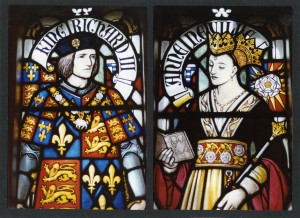
RIII and Queen Anne Neville – Stained glass window at Cardiff Castle (Source: Geoff Wheeler, Richard III Society)
This window was also the reason which brought us in contact.
Mr. Cowan commented on that picture here on the KingRichardArmitage website and, instead of releasing that comment, I asked him, if he could share his wide knowledge with us here at the website at more length.
See for yourself, what wonderful article developed from that comment, as Mr. Jim Cowan can tell the mysteries, story and connection between Cardiff and King Richard III so very gripping:
♛
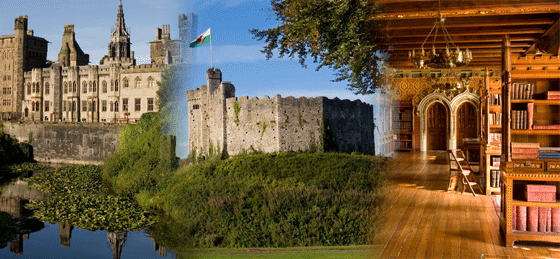
Cardiff Castle triptych (Source: Jim Cowan – Cardiff History and Hauntings)
Cardiff is a city that often surprises the casual visitor. It is the capital city of Wales and has the buzz and activity that you associate with such centres of population, but at first glance does not appear like a typical capital city. Where are the historic palaces and churches? Why is the Cathedral more than 2 miles from the city centre? Where exactly is the “historic centre”?
As a proud citizen of Cardiff, and lover of royal history, one thing which for many years frustrated me was that Cardiff did not enjoy the colourful royal associations of the other capital cities of Britain: London and Edinburgh both have their palaces and sagas of Royal intrigue, plotting, triumphs and calamities.
Cardiff, by contrast, is a city which most associate with the industrial revolution; a Victorian dockland town which boomed when the coal mined in the nearby Welsh valleys was in demand throughout the world and Cardiff was its outlet. However, so rapid and dramatic was that transformation, that Cardiff’s life before the 19th century has been almost entirely forgotten.
Discovering this colourful but little known history has been for me a wonderful voyage of discovery. The jewel in the crown (pun fully intended!) has been discovering that, throughout its history, Cardiff has had fascinating, intriguing and, at times, dramatic links to English Royal History from the 12th to the 21st centuries. To paraphrase the famous line attributed to the cult TV series “Star Trek”, you might say of Cardiff that “It’s a Royal City but not as we know it!”
We even have a period of Cardiff’s history where key characters from the last turbulent years of the Plantagenet dynasty have links to the town.
So how is this so? For 600 years prior to the Victorian coal exporting boom, Cardiff was, in British terms, of no significance whatsoever. Its population hovered approximately between 1,500 and 2,000 people. It was a walled town, and by all accounts fairly prosperous in Welsh terms: it was the largest borough in Wales and, as a staple port, was the chief port of south Wales for exporting the produce of an essentially rural economy, and importing vital supplies, primarily trading with nearby Bristol. However, that fact alone illustrates the insignificance of Wales since its resistance to Anglo-Norman invasion was finally crushed in the late 13th century. In contrast to Edinburgh and London it was never a centre of Government and never a Royal powerbase.
However, all throughout its history we find the Royal connections! Some are admittedly on paper only but others are far more dramatic. These connections begin with the arrival of the Normans in south Wales in the late 11th century, some two decades after William the Conqueror’s Norman Conquest. The south-eastern region of Wales was seized from the Welsh Prince Iestyn ap Gwrgan by Robert Fitzhamon. Fitzhamon made a base in Cardiff, on the site of a mighty but ruined Roman fortress. Cardiff Castle was born, with a classic Norman Motte and Bailey Keep.
Fitzhamon was given the title “Lord of Glamorgan”. Essentially this role was equivalent to Governor General for the region stretching from the South Wales border with England to South West Wales. The Lord of Glamorgan would wield considerable power and autonomy and his was the most powerful of the so called “Marcher” Lordships, which, until the 16th century, existed along the entire English-Welsh border, to keep England safe from Welsh resistance. Through this title, its office and its system of inheritance, the Royal connections with Cardiff began.
Robert Fitzhamon, the First Lord of Glamorgan, arranged for his daughter Mabel to marry another Robert, the eldest illegitimate son of King Henry I. As the son of a King his upbringing had all the trappings of Royal privilege resulting in him being a brilliant soldier and tactical expert. This marriage brought the young suitor considerable land and titles, including inheriting the position of Lord of Glamorgan from his father in law, to which was added another title, 1st Earl of Gloucester. He fortified Cardiff with a stone keep which still stands today nearly 900 years later.
Robert is more commonly known as Robert the Consul and played a significant role in England during the 12th century struggle for the throne, between Henry I‘s daughter, Matilda (Robert the Consul’s half sister), and her cousin Stephen of Blois. During his Lordship events at Cardiff Castle changed the course of English Royal history when the castle was, in effect, occupied by two sons of Kings. One was Lord and Master of the castle, Robert the Consul, and the other his captive, Robert Curthose, Duke of Normandy, eldest son of William the Conqueror, and uncle of Robert the Consul. He was imprisoned following his failed attempt to depose his younger brother Henry I, spending the last eight years of his life the prisoner of Robert the Consul in Cardiff where he died in 1134.
The Royal link fleetingly re-emerges with Robert the Consul’s granddaughter, Isabel of Gloucester, in the late 12th century, with her marriage to Prince John, son of Henry II. Through that marriage Prince John took the title Lord of Glamorgan before the marriage was annulled and the title passed to relatives of Isabel.
From that point the title passed through a number of great noble families in the ensuing centuries including the De Clare family (the coat of arms of Cardiff still bears the three inverted Chevrons of this family); the Despenser family (one of whom, Hugh Despenser the Younger, was executed brutally in 1326 for his association with the ill fated Edward II), and the Beauchamp family.
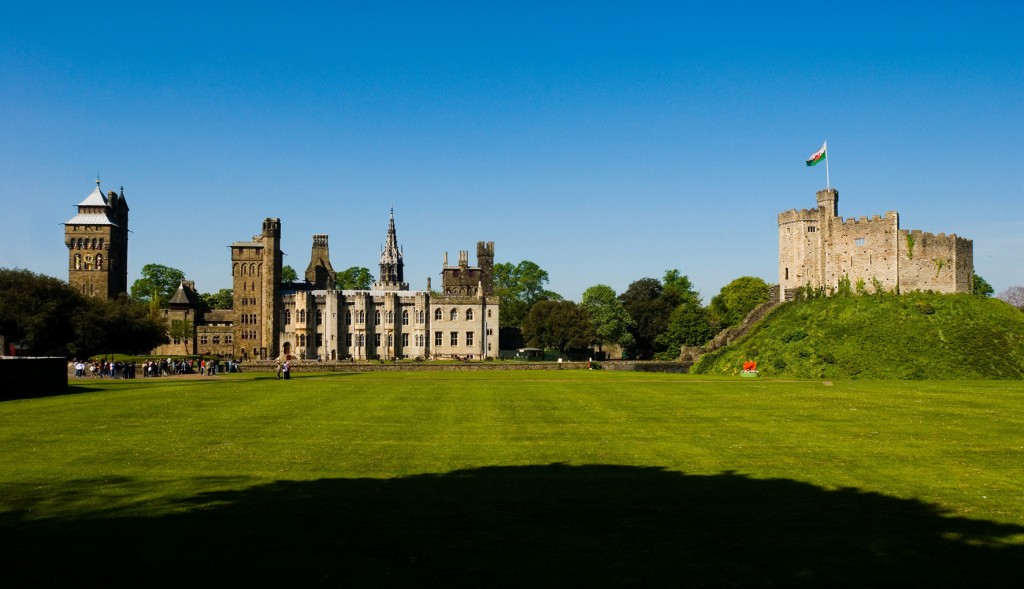
Cardiff castle showing Norman Keep and the main house with the grey bay windowed section the Plantagenet house (Source: Jim Cowan – Cardiff History and Hauntings)
The Beauchamp family were responsible for the creation of the house on the west wall of Cardiff Castle, which forms the core of the present castle apartments. Their construction followed the dramatic years of the early 15th century when Cardiff was, like many towns in Wales, all but destroyed during the great but ultimately unsuccessful Welsh uprising against the English, led by the powerful Welsh leader Owain Glyndwr.
It is in the mid-15th century, however, that we find Cardiff Castle becomes associated with some of the leading figures in the Wars of the Roses, between the houses of Lancaster and York.
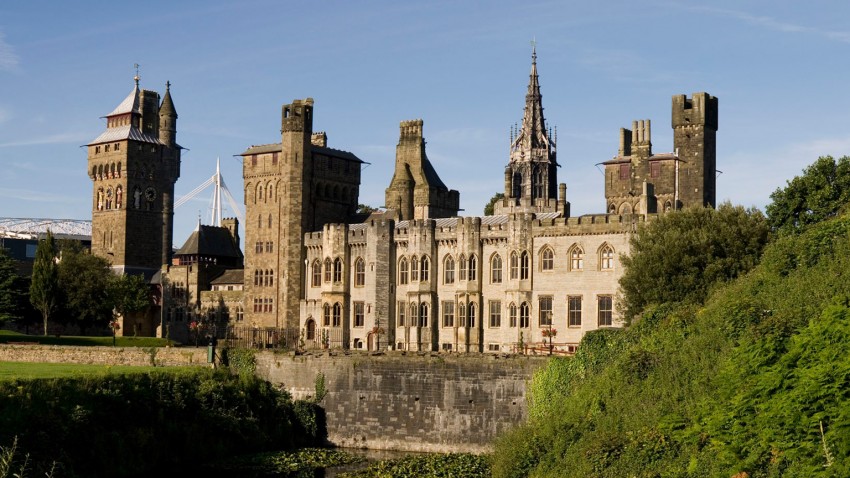
Cardiff Castle showing bay fronted grey stone Plantagenet house surrounded by the later Victorian Towers (Source: Jim Cowan – Cardiff History and Hauntings)
The Beauchamp claim to the Lordship of Glamorgan died out with their failure to produce a male heir. Eventually the Lordship was inherited by Anne, Countess of Warwick. Females were unable to carry the title in their own right, so it was assumed by her husband: Richard Neville, better known as Warwick the Kingmaker. Following his death at the battle of Tewkesbury in 1471 the title passed to George Duke of Clarence, spouse of his eldest daughter Isabel, who held it until his death in 1477. After that time the title passed to Richard of Gloucester, spouse of Warwick’s other daughter, Anne.
Richard of Gloucester, of course, became King in 1483 which meant that de facto the Lordship of Glamorgan merged with the crown.
Richard Neville’s part in the general saga of the Wars of the Roses is widely known. What is frustrating is that so few details are known about the detail of life in Cardiff and Glamorgan at this time that we simply do not know the extent of the comings and goings of the Nevilles when they held the Lordship. Perhaps somewhere such details exist, buried and hidden as incidental detail and trapped in some archive for someone to discover one day. We see the references to Richard Neville in the Glamorgan Charters issued at this time but that is it. However, there are tentative clues to suggest that the Nevilles did more than hold the Glamorgan Lordship as a mere title.
For evidence of this we look not to political or military events at or directed from Cardiff Castle, but to something more aesthetic which still stands proudly to this day 200 yards from the castle: The Church of St John the Baptist.
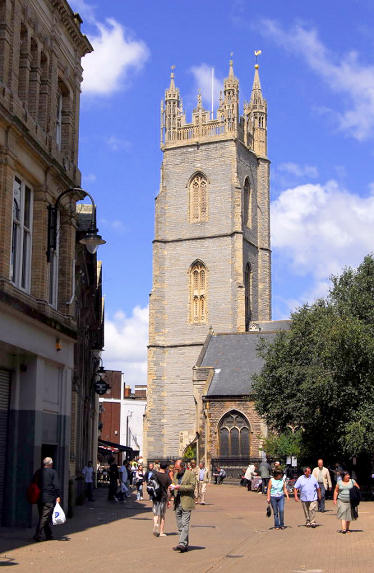
St Johns Church tower, Cardiff (Source: Jim Cowan – Cardiff History and Hauntings)
While the Nevilles held the Lordship, a new building began to emerge in the city centre. The Church of St John the Baptist had been in existence since the 12th century but the old building had been destroyed during Glyndwr’s 1404 attack on the town, which he had viewed as an English Colonial outpost.
The new Church was unlike anything seen in the town before: a 40m (130 ft) high tower emerged, taller than any building in the town, topped by a flourish of pinnacles. To this day no church tower in the southern half of the UK has as many ornamental pinnacles as this one. It was a sign that there was serious finance and intent behind its construction. Where could this support have come from? Certainly not the merchants of Cardiff. Cardiff was too small and modest for such opulent gestures.
The answer comes in a document contained in a church a few miles west of Cardiff. The 1721 register of the Church of Llanblethian, Cowbridge, contains the following entry:
“Anno 1473 Anne the second daughter and co-heir of Richard Neville the late Earl of Salisbury and Warwick was married to Edward Prince of Wales, son of King Henry the sixth. She was late Lady of the Manor of Glamorgan and Morganwg. Built this Tower the south part of Cowbridge Church and St John’s Tower in Cardiff was also married to Richard Duke of Gloucester afterwards King of England by usurpation…..”
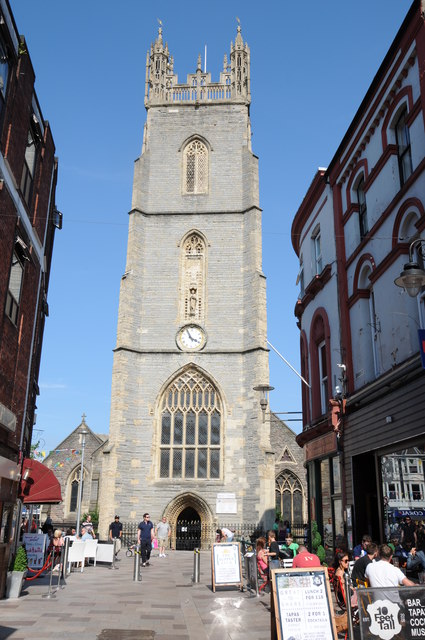
St Johns Tower, Cardiff (Source: Jim Cowan – Cardiff History and Hauntings)
It would be wonderful to have some evidence that, while Lord of Glamorgan, Richard himself ever spent time in Cardiff Castle. The official line taken by the castle is that there is no evidence that he did. However, I tend to take the view that he may well have spent time there, even if it was brief. While there is no official record of his presence in Cardiff, Richard was known as a keen administrator. As Lord of Glamorgan from 1477 it would have been in character for him to oversee personally, even if only occasionally, the running of the region for which he was responsible. Had he come to Cardiff then business would probably have been conducted from the Plantagenet Hall of Cardiff Castle. In the nineteenth century this was remodelled into (and remains) the library of the castle.
Sadly we have no more than such speculation on which to base thoughts on Richard’s link to Cardiff. However, we have the visual evidence on which to base our imaginings, not only in St John’s Church, but with the Plantagenet exterior of the Cardiff Castle apartments.
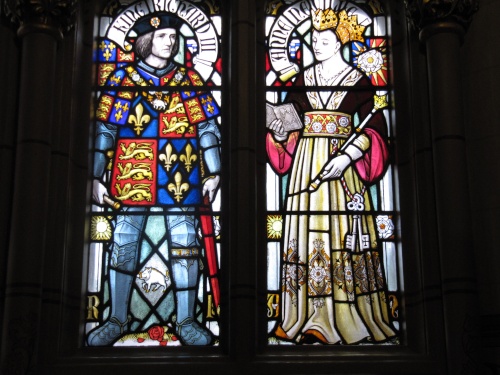
Richard & Anne – Cardiff Castle Window, 19th century (Source: Jim Cowan – Cardiff History and Hauntings)
In addition, the castle rooms are lined with stained glass windows of every Lord of Glamorgan from the twefth century creation of the title to its 16th century dissolution by Henry VIII (the last Lord of Glamorgan). This is thanks to the talented nineteenth century designer Charles Campbell, part of the team of the ingenious art architect William Burges, whose patron was the Third Marquess of Bute, richest man in Europe, and owner of Cardiff Castle, who transformed the building into a spectacular fairytale monument to his ancestry through gold, glass, marble, stone and wood. Whether by accident or design, as you enter the castle apartments, the first two figures you see are Anne Neville and Richard III beautifully portrayed in stained glass. It would be difficult to find in south Wales a more fitting place of pilgrimage for anyone seeking to discover and revere this much maligned figure.
by Jim Cowan,
Cardiff History and Hauntings
♛
Links: King Richard Week 2013 & Quiz
KRA-Week 2013-5: Fitzg – Sumptuary Laws
Links: King Richard Week 2013 & Quiz
♕ ♛ ♕
SUMPTUARY
Sumptuary laws
in Medieval and late medieval England.
(by Fitzg)
“Laws made for the purpose of restraining luxury or extravagance, particularly against inordinate expenditure in the matter of apparel, food, furniture etc.”
Black’s Law Dictionary.
English Sumptuary Laws date from 1281 in extant documents. They were then an expression of the Feudal System (every man in his place, dressed according his station. Women too.) The hierarchy must be established according to the “natural law”.
The next documented Law is that of 1309. This relates to conspicuous food consumptions of the nobles. (Peacocks presented at table, complete with feathers re-attached to the roasted fowl…)
Perhaps Edward III felt that such expenditure by his magnates reduced their monetary contributions to his Scottish and overseas wars.
Obviously, Kings and their families were not restricted by such fiscal management restraints.
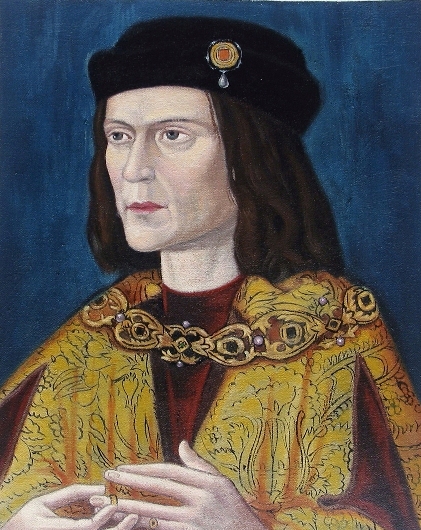
cloth of gold – Richard III earliest known copy of original; dated early 16th century (Source: Society of Antiquaries, London – Wikipedia)
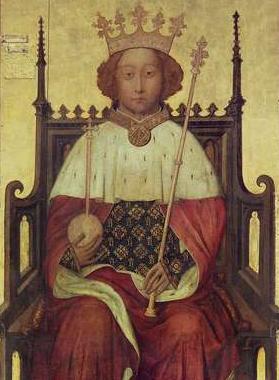
Richard II, c. 1390s. (Source: Westminster Abbey – Wikipedia)
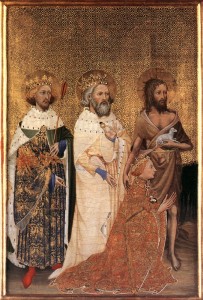
Wilton Diptych (Source: National Portrait Gallery, London – Wikipedia)
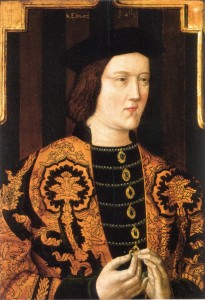
Edward IV. Portrait early 16th century (Source: Society of Antiquaries – Wikipedia)
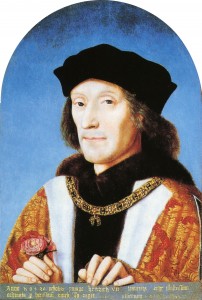
Henry VII, c. 1505 (Source: National Portrait Gallery, London – Wikipedia)
Cloth of gold, fur, gold…. It appears that the first Tudor, despite a somewhat austere, penny-pinching reputation, at least in the popular version, was not averse to personal display.
However, there was considerable Church disapproval of courtly display of fashion “trends“. Shoes, in 15th C, were an issue with the Church: the vanity of the elongated toes.
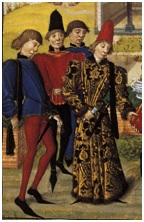 |
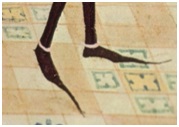 |
 |
And then, there was the Disney head dress. The Henin, and variations thereof.

Hans Memling, Lady Donne of Kidwelly. The Donne Triptych, c. 1478 (Source: Wikipedia)
The middle class was rising in wealth, and becoming uppity in dress. Note the quantities of costly material in the sleeves and gowns and richness of dyes.

Hans Fouquet, the Melun Dipptych, c. 1452 (Source: Wikipedia)
Etienne Chevalier, was not a merchant, but a trusted civil servant.
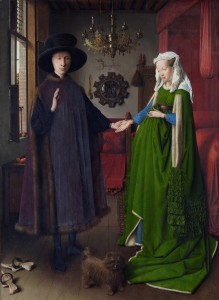
The Arnolfini Wedding, Jan van Eyck, c. 1434 – Italian merchant and his wife (Source: National Portrait Gallery, London – Wikipedia)
Disconcertingly to the “enforcers” of the Sumptuary Laws, the merchant class rose inexorably. The merchant class accumulated wealth, based on wool and textiles, and import/export. They bought off the enforcers’ fines, and even lent funds to cash-strapped nobility. They were going to wear what they had earned. Their wives (and often mercantile partners/supporters) were an advertisement to their wealth and their often mutual hard work. (Take that, Enforcers! 😀 )
England has not been quite as rigidly class-ridden as might be thought – upward mobility was mobilised. From 15th century sheep farmers, the Churchills were Dukes of Marlborough two centuries later. A middle class was firmly rising throughout Europe, driven by trade – wool/textiles/luxury goods from the East. The sheep farmers became merchants (and money-lenders), married into gentry and titled families, became senior civil servants.
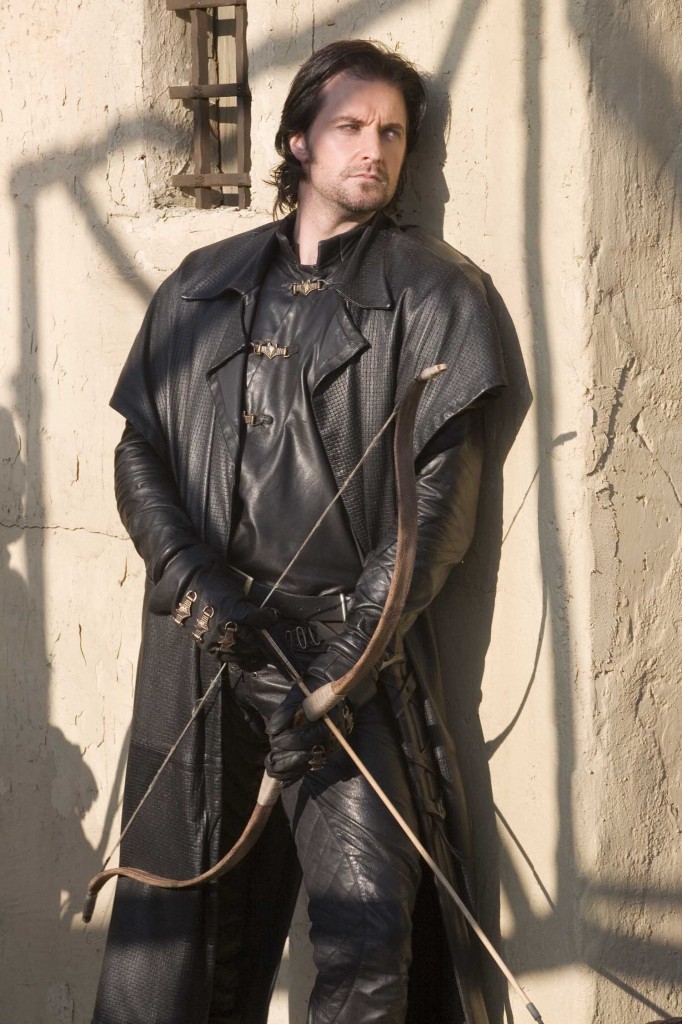
BBC “Robin Hood” Guy of Gisborne (Source: RichardArmitageNet.com)
Sir Guy of Gisborne, dressed head to toe in costly leather. Would a minor knight, in possession of an obscure provincial manor, pass the Sumptuary laws? Leather tanning and production were extremely costly, as is the case today. Perhaps; it didn’t involve cloth of gold or furs….
And Many Happy Returns to Richard Armitage on August 22 2013.
Respects to King Richard III, may he please be laid to rest as befits an anointed monarch.
SOURCES (for the costume-obsessed)
- www.medieval-life-and-times.info-medieval-clothing/medieval-sumptuary-laws.htm
- www.medieval-castle-siege-weapons.com/medieval-clothing.htm
- www.batashoemuseum.ca/collections/permanent/history_western_fashions/medieval/index.hstml
- Boucher, Francois. 20,000 Years of Fashion; Henry H. Abrams Inc. New York.
Links: King Richard Week 2013 & Quiz
KRA-Week 2013-4: Peter Warzynski & Leicester
Links: King Richard Week 2013 & Quiz
♕ ♛ ♕
Interview with journalist Peter Warzynski
about
Leicester & Archaeology & King Richard III
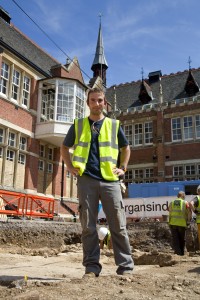
Peter Warzynski, Leicester Mercury – at the digging site where King Richard III was found. 7/2013 (Source: Peter Warzynski)
After yesterday’s interview with author Matthew Lewis, today we have an interview with journalist
Peter Warzynski from Leicester.
For all who follow the news about King Richard III here, he will not be a stranger.
Peter Warzynski is the knowledgeable reporter with the reliable news and information about Leicester and everything King Richard III. If the general news reports are vague about a topic, go find his article on the matter and you will certainly find the background and information you are searching for.
So I was very curious when Peter Warzynski wrote about his first hand experiences during the second digging at the location of the Greyfriars’ Church in Leicester in July 2013, and – surely not a daily occurrence for a journalist – I asked him for an interview, which he kindly granted.
The article in the Leicester Mercury with a fantastic picture of the digging area and his exact spot of research:
Leicester Mercury: Richard III dig: The hidden secrets of historic friary (20.07.2013)
And the description of his experiences during the archaeological research:
Leicester Mercury: Richard III dig: My brush with urban archaeology (22.07.2013)
With Peter Warzynski, I hardly could stop myself asking him questions. He is so knowledgeable about Leicester, has first hand experience about the digging, the location and the town.
Now, I hope you will enjoy the interview as much as I did while getting all my curious questions answered:
♛
Can you tell us a bit about yourself, your background as a journalist and your connection to Leicester?
I was born in Leicester, in the city, just a few miles from the car park where they found the remains of Richard III.
I’ve been a journalist for about eight years, starting at BBC Radio Leicester and moving to the Leicester Mercury about five years ago. I now live in Wigston, about five-miles outside of the city centre.
What is your impression about how the people of Leicester feel about the discovery and King Richard III himself?
I haven’t heard anything negative about the discovery from people in Leicester. Everyone is over-the-moon that we have a king buried in our city… and they’re even more excited about the fact that he will be reinterred at the Cathedral next year. Hopefully. The legal battle for the remains could push things back, but if the High Court sees sense it will make its decision quickly and the reburial can go ahead as planned.
The influence of Richard III in Leicester and Leicestershire is huge. We have the annual Battle of Bosworth re-enactment, we have roads, towns, schools and places named after him. We have statues, monuments and plaques dedicated to him. And we are in the process of building a museum in his honour.
How is the influx of visitors generally seen for / in the town?
Tourism is not our greatest industry, but we do fairly well.
Saying that, since the discovery of Richard III, it has boomed – and you can see that people are jumping on the bandwagon and using the king to promote their shops.
Advertising for local businesses suddenly has a Richard III theme and tour operators are offering packages to holiday makers which include all of the Richard III related sites.
More than 100,000 people have visited a small, temporary exhibition at the Leicester Guildhall, in the last few months. They have travelled from America, Australia, Asia in their droves and queued for hours to see the humble exhibition.
Next year a £4m permanent visitor centre will open, which will feature the grave of Richard III and is expected to attract millions of tourists.
It remains to be seen how long the initial explosion of excitement will last, but judging on how well people have taken to it, I think it’ll be a sound investment.
It had always been clear that King Richard III had been buried in Leicester after the Battle of Bosworth, but what does the knowledge that he indeed is there and finally found change for Leicester?
I don’t think it has always been clear. There was evidence to suggest he was buried by the Grey Friars, but where exactly that was has been a mystery for years.
Granted there was evidence to show that he was at the friary, but then again there was conflicting accounts to say he was elsewhere.
One of the main changes, now we know we have his bones, is the way Richard’s story is taught in school. Until the bones were identified, people still argued that his remains were dug up at some point in the past and thrown into the River Soar. That myth has now been quashed.
There is still quite a bitter debate over who identified the real location of the grave since the Greyfriars dig.
John Ashdown-Hill, who tracked down Michael Ibsen – Richard III’s 16th great grandnephew – claims he pinpointed the grave first.
However, the University of Leicester says that one their own – a lovely chap named David Baldwin – was the first person to positively identify the final resting place of the Plantagenet monarch.
Were you interested in King Richard III and his story before the digging in Leicester began?
Everyone in Leicester knows about the story of Richard III because he has had such a big influence on the city and the county.
As I mentioned before, the Battle of Bosworth is re-enacted every year. (In fact, this year, a German (Bavarian) man by the name of Andreas Wenzel will play the role of Richard at the anniversary re-enactment.)
So all Leicestershire folk have an interest in the former King – everyone I know has read Shakespeare’s imagining of him at school at some point.
I have an interest in history anyway, so this is very much up my alley (so to speak), and I the fact that history is playing itself out on my doorstep is fantastic. I also hope it will inspire others to become interested in history too.
King Richard III, though dead for over 500 years by now, still awakens great emotions, varying from hatred to support and loyalty. What do you think might be the reason for this heated debate about him, when other royals or historical figures can expect a more ‘neutral’ research into their life after such a long time?
Richard has polarised people for hundreds of years because nobody really knows what he was like. Or at least nobody knows the complete truth. There have been so many conflicting accounts written about him, it is impossible to determine what the man was truly like.
Did he murder the Princes in the Tower? Did he die bravely in the thickest press of his enemies? There’s nothing to sat he did both – or neither. This is the problem with trying to establish his character.
I believe that Richard ruled and acted like a typical medieval monarch. As far as people of the time were concerned, he was a conventional king.
I think that because very little is known about him, and due to a war of slander and deformation with Henry VII, what people think they know is shrouded in uncertainty – and it is very easy people to pick and choose what they believe and discount the pieces of history that don’t fit with their image of him.
The problem with my point-of-view of Richard is that by sitting on the fence I manage to alienate both the supporters and detractors with my boring uncommitted open-mindedness.
What did King Richard III and discovering his remains in Leicester change in your life?
Has your attitude / awareness for Richard III in your town (city) changed since the beginning of the digging? Was the digging you could join able to change your perception / perspective?
The discovery has changed the way I view archaeology.
I worked with the University of Leicester dig team on the second Greyfriars excavation, which finished a few weeks ago. It was at the same site and the grave of Richard was still visible – but this time the team was looking for more information about the friary itself.
The experience was like a roller coaster – one minute I was laboriously brushing the dust from the 50th broken tile I had found, daydreaming about what I was going to have for dinner that night. The next I was lifting the lid from a 600-year-old stone coffin to reveal what everybody thought would be a medieval knight, or the founder of the friary. I say ‘thought’, because what we actually found was a second lead coffin inside the stone tomb – a surprise for everybody, even experienced site director, Mat Morris – who found Richard a year ago.
After taking part in the dig, I realised just how unbelievably unfathomable it had been that the team had stumbled upon Richard’s grave the way they did.
When I spoke to Richard Buckley – who led the project – on the first day of the original Greyfriars dig in August 2012, he said he would eat his hat if they found anything. He was convinced the best the team would do is find part of the medieval friary – maybe the church.
So it goes to show how unexpected the find was.
Were you interested in archaeology before King Richard III was searched and found? If yes, why and how did you get information, what interested you?
What interests you now, after you have experienced a digging yourself?
I was interested in archaeology the same way most people are interested. I like books and documentaries about Egyptian tombs and Mayan ruins – not city centre digs.
Now, however, I think there’s something to be said for urban archaeology.
Since the discovery of Richard III, I have written a few more stories for the newspaper about other digs in Leicester – not connected with the Greyfriars – and I’ve learned a lot about the history of the city – who founded it, how the first settlers lived, when the Romans moved in, when the Romans moved out and how Leicester grew.
Digging so close where King Richard III was found, what aspect was more important to you. To get more knowledge about archaeology in general, about the history of your town or possibly about a famous king, who had gone missing some hundred years past?
I think all three tie in together. The more I found out about archaeology through working with the team, interviewing the archaeologists and reading about the project, the more I understood how amazing the story of Richard III was.
The University of Leicester maths department calculated that the odds of finding the remains was less than one per cent.
When you learn that only 17 per cent of the friary is not buried beneath buildings, walls or roads – that in itself is amazing.
If Richard had been interred anywhere else in the remain 83 per cent of the friary – which is unreachable – he would never have been found.
How important was the factor of good weather for your digging? What influence did it have on your results and speed of your digging?
It didn’t really have that much of an impact. The sun dried out the earth which made it difficult to photograph and catalogue because of the dust – it settled everywhere and made the whole place one uniform colour. It meant that details on stonework and tiles were indistinguishable from other nondescript areas. So before every photo was taken the whole site had to be hosed down and watered to bring out the detail and colour of the archaeology.
What methods did you see and were allowed to do yourself during the dig?
The dig process was mostly a meticulous one. First the heavy machines come in and remove the Tarmac and top soil. Then the archaeologists take over once they feel they’re close to the archaeology. My role involved using mattock – a type of pick – to carefully remove layers of soil and then once I’d come across something of interest – which mainly turned out to be medieval floor tiles – I would use a trowel and brush.
However, like I mentioned before I was also there when the stone coffin of Sir William de Moton (although it could be a number of other likely candidates) was unearthed, which was very exciting.
When we removed the stone lid, everyone expected to see a skeleton. But what we found was a second lead coffin inside, which is now at the university undergoing analysis.
In what aspects was archaeology more difficult and harder or easier than you expected?
Did the archaeological research and the used methods meet your expectations?
There’s a lot of manual labour involved. Shifting large wheelbarrows full of soil and debris from the excavation site.
One minute you’re heaving big clumps of dirt from the earth, and the next your being very careful because you’ve found ‘something’ which might be very interesting – and you have to change tact and be very gentle.
Anyone can do the bits I did. The hard part comes when you have to identify what it is you’re digging – and knowing when to stop smashing the ground with the mattock and use you trowel instead. Luckily, I was working with an experienced archaeologist the whole time – and I was probably asking very stupid questions.
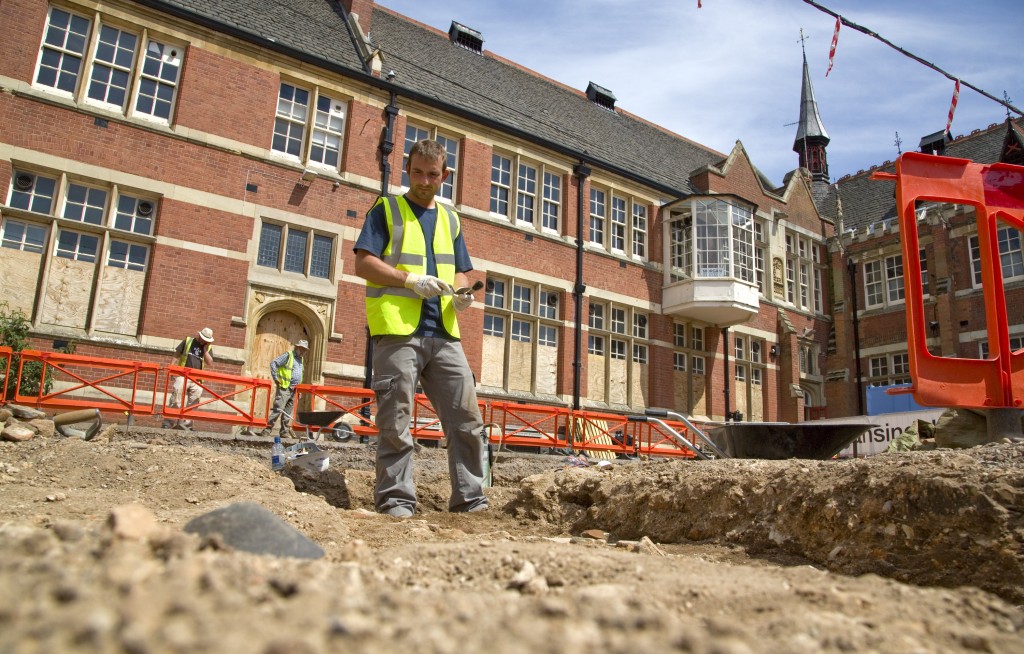
Peter Warzynski, Leicester Mercury – at the digging site where King Richard III was found. 7/2013 (Source: Peter Warzynski)
Your trench 4 looks rather level and not very deep, compared to some other trenches. Was this because of the richness of tiles already preserved in this upper soil section or did you later go deeper as well in a presumption that the area might have been filled in with debris from the destroyed monastery?
That was the top of the trench. Once the tiles had been catalogued and photographed we smashed right through them and continued deeper down. I was a bit taken aback by this. I thought we should be preserving them and removing them from the ground for storage.
However, it was explained to me that if the archaeologists did that with everything they found, especially the hundreds of broken tiles, they would soon run out of room to store them. They told me that the only way of finding out what was buried below their feet was to dig down, record what they had found and keep going. Much of the archaeology they came across was unceremoniously hacked through once it had been recorded.
This is the way it has always been, ever since the first archaeologist picked up a mattock.
Your trench looks very close to the grave of King Richard III. Can you tell us more about the placement of this section in the presumed church layout?
What area did you reveal in comparison to the location of where the grave of King Richard III was situated? Had you hoped to find something with significance to King Richard III in the church?
The site that was being excavated was the choir of the church. A place where only the friars could go.
It was reserved for high status burials and the team actually uncovered – but did not exhume – a number of other remains during both digs.
It faces east to west, as is the tradition with churches, and included a presbytery – where the stone coffin was unearthed. To the north was the friary’s graveyard, which extends under the neighbouring building and the road which separates the site from the Cathedral (where Richard will be reinterred next year).
The second dig was not aimed at finding anything else directly related to Richard III. Historical records say that Henry paid for an alabaster tomb for Richard, but that was never found. It would have been interesting that had been uncovered.
The second dig was aimed at finding out more about the friary itself.
Might King Richard III have been able to make archaeology more popular?
Will superficial observers now, after King Richard III was found so quickly, think archaeology is a fast method? What impression did you get?
The way Richard III was found is certainly not common in archaeology. Archaeologists do not look for specific people – that is very rare. What archaeologists do is dig and see what they find. To go out with the specific intention of finding a particular person is almost unheard of, which is what makes this story even more fascinating.
So, with that in mind, this project might give people the wrong impression about archaeology.
The discovery has also kick started media speculation about other English kings and their presumed whereabouts, and there have been stories in the newspapers about searching for Alfred the Great.
I suppose people might think that archaeology is fast and easy after following Richard’s story. After all the team found him on the morning of the first day of the dig, in the first place they looked, in the first trench that they dug.
Will you attend the burial ceremony of King Richard III next year? What are you looking forward to most? What aspect of the ceremony do you think especially reflects on the person of King Richard III? What aspects do you think – as far as they are known so far – are more to appease contemporary sensibilities rather than King Richard III?
I will definitely be at the reinterment ceremony next year to report on the event, speaking to visitors from far-flung lands and enjoying the occasion for myself. I can’t wait. I’m also working with the cathedral on the plans at the minute, and I’ve been sworn to secrecy regarding the details of the service. Although, they haven’t really told me that much – I think they are still quite distrustful of the press.
The cathedral is not used to this kind of media attention (unlike the university and the city council) and I think it feels slightly uncomfortable.
Despite the judicial review into the exhumation licence, I still think Leicester will be the location of the reinterment. So I’m not worried about York snatching the bones from under our nose.
They could be famous last words, but common sense, and the law is on Leicester’s side. The spurious claims of the Plantagenet Alliance – that they are in some way related to the king – will be shot down within seconds. Richard III has millions of relatives in the UK, with an equal right to the remains.
The fact is, after 500-years, almost everyone in England who can trace their family tree back to the 15th century will find some link to Richard.
This is why the High Court judge, Mr Justice Haddon-Cave, has agreed to hear the case, because he says the country should decide. But then by allowing the debate he’s giving priority to what will only amount to an argument, rather than to the law – which the University of Leicester followed to the letter when they applied for the exhumation licence.
Whom would you invite to attend the burial ceremony, if invitations were left in your hands?
I do think there should be a member of the Royal Family there.
What is your impression of King Richard III now, after all your experiences and your intense occupation with the research? What is your impression now, in comparison with what it was before the search in Leicester even begun?
There has been a lot written about how he has been misrepresented throughout history. I think the argument that he wasn’t as bad as people say does have its merits, but I still think he would have behaved like a monarch of the time – and that means he may not have been a complete angel either.
But whatever kind of king he was, he was buried in Leicester… and Leicester is where he should stay.
♛
Now I am certain you see, why I had such a hard time to stop myself from asking questions from my interview partners.
I hope you enjoyed both interviews with Peter Warzynski and yesterday’s with author Matthew Lewis.
More articles and interviews will follow in the next days.
Don’t forget to take part in the Quiz till the 27th at midnight to have a chance to win!
(Though it starts with questions about actor Richard Armitage, most questions are about King Richard III !
So it is not only for RA-experts, but for history buffs as well!)
Links: King Richard Week 2013 & Quiz
KRA Week 2013-3: History & Law – Author Matthew Lewis
Links: King Richard Week 2013 & Quiz
♕ ♛ ♕
Interview with author Matt Lewis
about
his research & King Richard III
First of all, I need to confess, having such a knowledgeable author and researcher as interview partner let my curiosity run away with me. I hope you will enjoy the wonderful and insightful answers by author Matt Lewis.
Matt Lewis also currently publishes a series of articles in defence of King Richard III on the Royal Central blog
- The Real White Queen? A Defence Of King Richard III (02.08.2013)
- The Defence of Richard III Part 2 – The Foundations of Evil (06.08.2013)
- The Defence of Richard III Part 3 – To Kill A King (11.08.2013)
- The Defence of King Richard III Part 4 – Bosworth, Shakespeare & That Horse (22.08.2013)
and an interview by Karen Kilrow with more background was published there (13.07.2013).
But now to the interview and my curious questions:
Can you tell us a bit about yourself and your historical background?
I have been passionate about history since school, where it was my favourite subject. I studied the Wars of the Roses there and it immediately grabbed me. The intricacies of the family ties, the loyalties and the betrayals are like the plot of the most complex tv series you ever watched, only this was real people’s lives being torn apart.
The story of Richard III was also something I was immediately fascinated by. The difference in his reputation before 1483 and after was so diametrically opposed that it just didn’t make sense. I had to learn more! An interest became a passion. I read book after book about the Wars of the Roses and Richard III and the more I read the more convinced I became that something was amiss.
How does your legal background fit into your interest for history?
At university I studied law and even that seemed to complement the study of history. I find that having a law degree complements an interest in history very well. A solicitor I worked for once told me that no one knows all of the law, the trick is knowing how and where to find what you need. This principle applies to history too. No-one knows all of history.
The skills of research are the same. A law degree teaches you how to find facts, examine and understand them from all angles, to view things from the perspective of others and then present your findings. Historical research is identical. When writing fiction, legal training helps further because it teaches you to understand the facts and then make them prove what you need them to prove!
Why is it so difficult to get unbiased research into the life and times of Richard III, even more than 500 years after his death?
It is hard to understand why Richard III doesn’t get the kind of impartial study almost anyone else does. I think it is due in part to history, for purposes other than academic study, liking to box people up neatly as ‘goodies’ and ‘baddies’. The Tudors followed Richard and were keen to present a picture of an England ravaged by tyranny from which they saved a grateful people. Obviously he was then maligned by Shakespeare and that image of him stuck. There has always been a core of historians keen to shine the light of fact on his reputation but it has been hard to fight against a presumed, accepted image. Because of this the argument becomes more polarized as some believe him an evil tyrant and others try to paint him as a saint. Somewhere in the middle the real man is lost. He was neither a saint nor a demon and until the argument moves away from such passionate polarization it will always prove hard to judge him dispassionately.
Might this difficulty to get some resemblance of ‘justice’ for a historical figure have something to do with the current royal family descending from those getting into power after the Battle of Bosworth or the perception of a need to legitimize the later religious separation from Rome or have something to do with a modern interpretation of what monarchy and democracy should be or do?
I think that the present royal family have little impact on the study of the history of personality. They would, I suppose, have a vested interest in the institution of monarchy and so would not wish to become embroiled in any kind of discussion of rights and wrongs. To do so opens them up for such criticism in the future. It is for this reason, I suspect, that the royal family is not keen to allow the opening of the urn in Westminster that supposedly contains the remains of the Princes in the Tower and of other royal tombs such as Edward IV’s for DNA comparison. I doubt that it relates to insecurity or rivalry but rather to the sanctity of those graves. There are human beings resting in peace there. If permission were given now, the same could happen in the future to those still alive now and they may well not want that. Whatever the rights and wrongs of Bosworth, Henry VII was anointed king, whether by right of blood or conquest becomes irrelevant. No-one could challenge the legitimacy of the current royal family now on that basis. If we look further back, Edward IV took the throne by force, as did Henry IV. Do we then head back to William the Conqueror?
Will finding the ‘real’ King Richard III now help with the research to also start the search for the ‘real’ person, not the legend?
The discovery of Richard III’s grave is an opportunity that I hope will be exploited to the full by those seeking a re-evaluation of his reputation. I noticed a real surge in sales of my novel when it was announced, so clearly interest has been captured and just needs to be exploited. The White Queen series has drawn attention to the Wars of the Roses period too. Visitors are pouring in to the exhibition at Leicester and I hope that they will be taking away a different perspective on him, if they are not already Ricardians! I was lucky enough to visit the dig site at Greyfriars on one of the open days and it sent a chill down my spine to think that I could be standing so close to the remains of a man I had studied for so long. I was like a crazed fan. I find it amazing that after everything that has happened on that site – the demolition of the monastery, the building of the mayor’s house and gardens, the demolition of that and all of the subsequent Victorian work, not to mention the laying of the car park – that his grave remained intact and unspoiled, missed by every pick axe and digger that had been on the site. His funeral will be another huge event, unlike anything we have seen before. It would be fantastic to make it there and I will be doing my best to attend some part of it.
I hesitated a bit with the following question, not wanting to heat up the brewing battle. But Matt Lewis answered my question about King Richard III’s last resting place with grace and historical knowledge, so I need not have worried:
With all the discussion about the ‘Battle of the Cities’, what is your position regarding the fighting towns York and Leicester?
In terms of where he should be laid to rest, I have no issue giving my preference. From the very outset there has only been one place that I believe he should be buried and that is Westminster Abbey. He was a king of England and deserves no less. Much has been made of Leicester’s right to him and York’s desire for him. Indeed, it has been claimed that he wanted to be buried at York Minster. Whilst he was lord of the north for his brother this may have been his intention but by the time that he died he was King of England. The clearest indication of his final wishes is the fact that he had his wife buried at Westminster. He may well have intended to have their son moved there from Middleham too, but I think Anne’s presence at Westminster tells us all that we need to know about his wishes.
How do you see the legal aspects of the appeal by the relatives of King Richard III, the Plantagenet Alliance?
The legal challenge that has been brought is flawed in so far as those bringing it are not descendants of Richard III, they are descended from his siblings. It is also my understanding that the reburial of remains discovered during an archaeological dig does not require consultation with the relatives where the remains are over 100 years old, as those of King Richard clearly are. Best practice is to have remains interred at the nearest church or cathedral to the location they were discovered too. Leicester University appear to have done all that was required of them and I suspect that their wish to have him buried at Leicester Cathedral will be, in the end, granted.
You wrote a historical novel about Richard III, clearly depicting Richard III as human being, not the caricature not only Shakespeare, but also some historians made and still make him.
What is your reason to do so and where do you see you have to add to all the previous works and novels about Richard III?
I wrote my novel as an indulgence really. It took about 10 years of picking it up and putting it down but I enjoyed writing and researching it. I tried to remain as historically accurate as possible, not least because the true story is far too interesting to have to invent anything! The book looks at the more domestic side of Richard’s life from the Battle of Barnet when he helped his brother Edward IV regain his throne to Bosworth. Most people know about the battles he fought, the seizure of the throne, the Princes in the Tower and the Battle of Bosworth but I wanted to explore him as a more rounded person, at home with his wife, relaxed with his friends, but still dealing with huge issues of national importance. ‘My’ Richard has faults, too. He is far from perfect. His temper is short and his inability to understand those who do not share his views leave him politically naive and exposed. The actions that he takes in the book broadly follow the known history, so if he attracts sympathy for his actions, it is because he deserves it.
Whatever you decide about him by the end, at least it will be based on fact rather than accumulated mythology.
Studying law helps to view things dispassionately, to detach from them and present them objectively. I am an ardent Ricardian, though I don’t necessarily belief he was without fault. I hope that by presenting a man trying his hardest to make his way in a hostile, uncertain world, struggling to protect his family, I could balance out the saint v tyrant argument a little.
To what extent is your work “Loyalty” based on the research by Jack Leslau about the image interpretation and connection between Sir Thomas More and Hans Hobein? (Research presented on the website: www.holbeinartworks.org)
I first read a brief reference to Jack Leslau’s work in A.J. Pollard’s King Richard III and the Princes in the Tower. It fascinated me and I read more. The more I learned the more interesting it became. In the end it provided the frame through which Richard’s story is told, so there is no doubt that it influenced me a great deal. Ricardians will probably know what that means for the story, but it is not well discussed beyond this. The sequel, which is nearing completion, follows both threads of this story to something which I believe is entirely new. At least I have never come across my next theory before! Holbein returns and we also follow the aftermath of Bosworth as those loyal to Richard who survive try to find a place for themselves in a changed world, a world that hunts them.
You wrote two further works about King Richard III and the Wars of the Roses. Both are rather short volumes with highly condensed information, giving an excellent overview of events and happenings.
What was your reason to write those and for which audience are they intended?
I have begun a series of brief factual history books offering my take on the period I love. A Glimpse of King Richard III was born of the new interest in the king and is a very short biography. It is aimed squarely at those interested in the subject because of the recent discoveries and discussions but who do not wish to dive into a weight biography – though I enjoy these immensely, they are not for everyone. I thought those with a casual interest might pick it up and hopefully put it down with a different perspective on King Richard III. A Glimpse of the Wars of the Roses adds depth to the subject but is also brief, beginning with the roots of the conflict and then following the chronology of the politics and the battles. Again, with interest high and The White Queen drawing much attention, I thought some with a more casual interest in the period might find it interesting. There is more to come in the series too. Hopefully people will enjoy my lighter take on the complexities of the period.
Book publications currently available by Matthew Lewis on Amazon.com / Amazon.co.uk
:
* * *
* * *
* * *
Links: King Richard Week 2013 & Quiz


